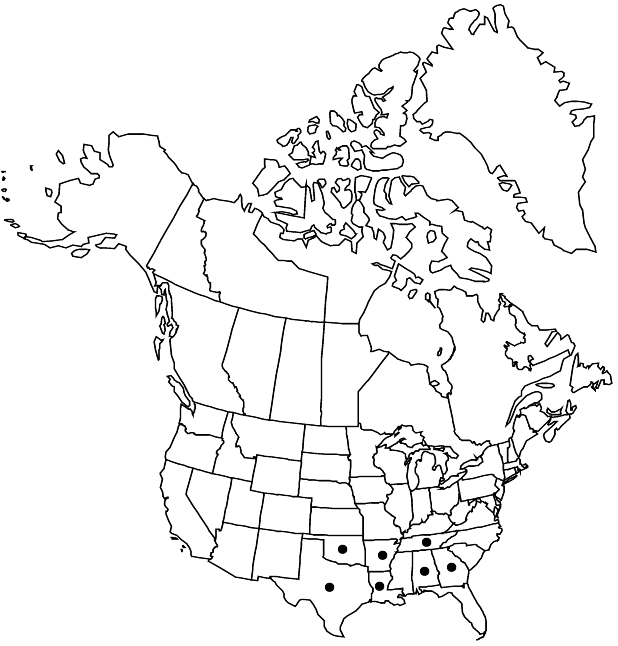Difference between revisions of "Ribes curvatum"
Bull. Torrey Bot. Club 23: 295. 1896 (as curvata) ,.
FNA>Volume Importer |
imported>Volume Importer |
||
| (3 intermediate revisions by 2 users not shown) | |||
| Line 7: | Line 7: | ||
}} | }} | ||
|common_names=Granite or Georgia gooseberry | |common_names=Granite or Georgia gooseberry | ||
| + | |special_status={{Treatment/ID/Special_status | ||
| + | |code=E | ||
| + | |label=Endemic | ||
| + | }} | ||
|basionyms= | |basionyms= | ||
|synonyms={{Treatment/ID/Synonym | |synonyms={{Treatment/ID/Synonym | ||
|name=Grossularia curvata | |name=Grossularia curvata | ||
|authority=(Small) Coville & Britton | |authority=(Small) Coville & Britton | ||
| + | |rank=species | ||
}} | }} | ||
|hierarchy=Grossulariaceae;Ribes;Ribes curvatum | |hierarchy=Grossulariaceae;Ribes;Ribes curvatum | ||
| Line 35: | Line 40: | ||
-->{{#Taxon: | -->{{#Taxon: | ||
name=Ribes curvatum | name=Ribes curvatum | ||
| − | |||
|authority=Small | |authority=Small | ||
|rank=species | |rank=species | ||
| Line 49: | Line 53: | ||
|publication title=Bull. Torrey Bot. Club | |publication title=Bull. Torrey Bot. Club | ||
|publication year= | |publication year= | ||
| − | |special status= | + | |special status=Endemic |
| − | |source xml=https:// | + | |source xml=https://bitbucket.org/aafc-mbb/fna-data-curation/src/2e0870ddd59836b60bcf96646a41e87ea5a5943a/coarse_grained_fna_xml/V8/V8_81.xml |
|genus=Ribes | |genus=Ribes | ||
|species=Ribes curvatum | |species=Ribes curvatum | ||
Latest revision as of 22:46, 5 November 2020
Plants 0.5–3 m. Stems erect to recurving, (rooting at tips), glabrous; spines at nodes (1–)3, 4–11 mm; prickles on internodes occasional. Leaves: petiole 1–2.5 cm, pilose and with long-stalked glands, proximal hairs plumose; blade roundish, 3-lobed, cleft 1/2 to midrib, 1–3 cm, base broadly cuneate, surfaces with pilose hairs and punctate glands abaxially, pilose, glandular adaxially, lobes rounded, parallel-sided, margins toothed, apex rounded. Inflorescences spreading, solitary flowers or 2–4-flowered racemes, 3–6 cm, axis glandular or short stipitate-glandular and sparsely lanate to sparsely pilose, sometimes nearly glabrous, flowers evenly spaced. Pedicels not jointed, 6–16 mm, glabrous or sparsely lanate or pilose, glandular or eglandular; bracts lanceolate, 2–2.5 mm, ciliate, with some glandular hairs on margins. Flowers: hypanthium white, broadly campanulate, 1–2 mm, scattered-hairy to subvillous; sepals not overlapping, spreading, white, oblanceolate, 7.5–9 mm; petals connivent, erect, white, rhombic, not conspicuously revolute or inrolled, 1.2–2 mm; nectary disc not prominent; stamens 4–5 times longer than petals; filaments slightly expanded to base, 6–7.5 mm, pilose; anthers cream, oblong-oval, 0.7–0.8 mm, apex rounded; ovary pilose, sessile- and short stipitate-glandular; styles connate 3/4 their lengths, 8–11 mm, copiously pilose-villous to above midlength. Berries palatability not known, greenish to reddish purple, globose, 7–12 mm, glabrous or hairy and glandular.
Phenology: Flowering Mar–May.
Habitat: Rich, deciduous woods
Elevation: 200-800 m
Distribution

Ala., Ark., Ga., La., Okla., Tenn., Tex.
Discussion
A report of Ribes curvatum in North Carolina is apparently based on cultivated specimens (A. S. Weakley 2006). The petal margins are entire or with an appendage on each side near the apex.
Selected References
None.